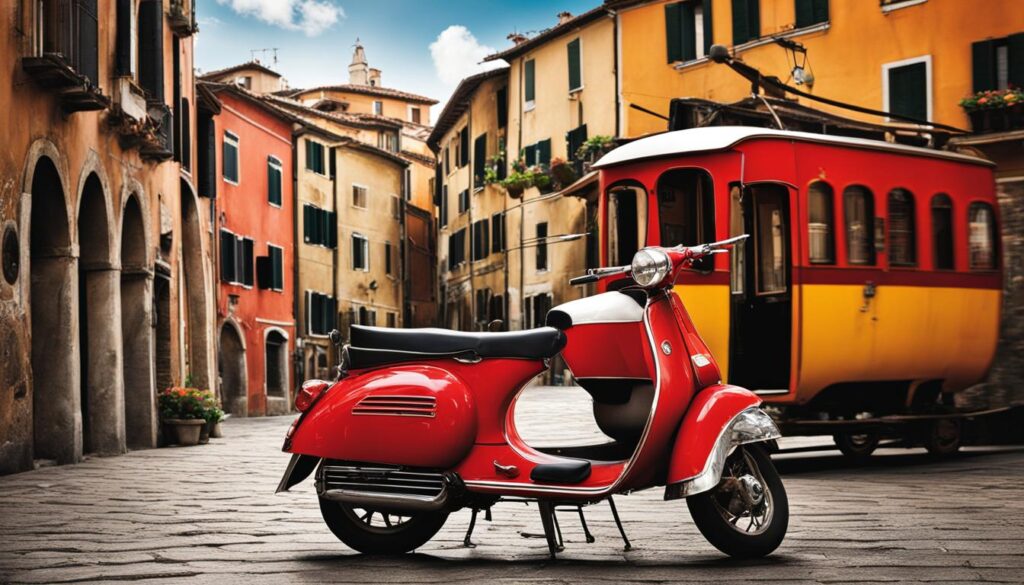Italy is a country bursting with culture, history, and stunning landscapes, making it a popular travel destination for people around the world. Before embarking on your Italian adventure, it’s important to understand the overall cost of traveling to this beautiful country. In this section, we’ll explore the expenses you can expect to encounter when planning your trip to Italy, including accommodations, transportation, meals, activities, and more.
From budget-conscious backpackers to luxury-seeking travelers, there are options for every type of traveler in Italy. However, the cost of your trip will depend on your travel style, preferences, and priorities. By being aware of the various expenses you’ll encounter, you can plan your trip accordingly and avoid any unexpected financial surprises.
So, how much does it cost to travel to Italy? Let’s dive into the details and find out. We’ll cover everything from accommodation to sightseeing to hidden costs, so you’ll be fully informed when it comes to planning your Italian getaway.
Accommodation Costs in Italy
Italy offers a vast range of accommodation options, from budget-friendly hostels to luxury hotels. However, your choice of lodging will significantly impact your overall trip expenses. It’s essential to budget for accommodations to avoid overspending and ensure an enjoyable stay in Italy.
Types of Accommodation
Hostels are the most affordable option and will cost anywhere between $15 to $50 per night. However, rooms in hostels are usually shared, and you may need to share a bathroom with other guests.
Hotels are another popular accommodation option. The prices vary depending on the hotel’s location and quality, but they range between $80 to $300 per night. If you’re on a budget, you can find budget hotels in the range of $80 to $100 per night.
Apartments are also an excellent accommodation option for families or groups who want to save on their Italy travel budget. You can rent an apartment for $60 to $250 per night, depending on the apartment’s location and size.
Budget for Accommodation
The amount you allocate for accommodation will significantly affect your Italy trip cost. If you’re on a tight budget, you can stay in hostels or budget hotels and save on lodging expenses. Budget travelers should allocate around $50 to $100 per night for accommodation in Italy.
If you can afford to splurge, you can stay in luxury hotels or rent a villa in the countryside. Luxury hotels in Italy cost anywhere between $300 to $1000 per night, while villa rentals range from $1500 to $5000 per week.
Tips for Finding Affordable Lodging
If you’re looking to save money on accommodation in Italy, consider these tips:
- Book your accommodation in advance to get the best rates.
- Consider staying in an apartment if you’re traveling with a family or group of friends.
- Stay in budget hotels in the offseason when prices are lower.
- Consider staying in the outer suburbs of popular tourist destinations.
- Use online travel booking sites to compare prices and find deals.
- Avoid accommodations located in the city center, which tend to be pricier.
Transportation Expenses in Italy
Italy is home to a well-developed transportation system, making it easy to travel within the country. However, travel expenses can quickly add up, so it’s important to budget accordingly. Here are some factors to consider when planning your transportation costs:
Flights
If you’re flying into Italy, be sure to shop around for the best airfare deals. Prices can vary significantly depending on the time of year and the airline you choose. In general, flights to major Italian cities like Rome, Milan, and Venice tend to be more expensive than flights to smaller airports.
Trains
Trains are a popular and convenient way to travel around Italy, with frequent routes and comfortable seating options. The cost of train tickets can vary depending on the distance traveled and the class of seating. For example, a first-class ticket from Rome to Florence can cost around $70 USD, while a second-class ticket can be as low as $20 USD.
If you plan to travel by train frequently during your trip, it may be worth considering a rail pass. These passes offer unlimited train travel within a certain timeframe and can be a cost-effective option for longer trips.
Buses
Buses can be a more affordable alternative to trains, but they may take longer and be less comfortable. Local buses within cities are typically quite cheap, while longer-distance buses can cost around $20-30 USD for a one-way ticket.
Rental Cars
Renting a car in Italy can give you more freedom to explore the country at your own pace. However, it can also be expensive due to rental fees, fuel costs, and tolls on highways and bridges. Prices vary depending on the type of car and the rental company, but expect to pay at least $50-60 USD per day.
When renting a car, be sure to carefully review the terms and conditions and consider purchasing additional insurance coverage to protect yourself in case of accidents or theft.
Tips for Saving on Transportation Costs
Here are some tips for keeping transportation expenses within your Italy travel budget:
- Book flights and train tickets well in advance to secure lower prices.
- Travel during off-peak seasons to take advantage of lower prices.
- Consider taking local buses or walking instead of using taxis or rental cars.
- If you do rent a car, choose a smaller, more fuel-efficient model to save on gas costs.
- Look into discount options like rail passes or multi-day bus tickets.
Dining and Food Costs in Italy
One of the most exciting aspects of traveling to Italy is experiencing the rich culinary tradition of the country. From pizza to pasta, gelato to espresso, Italy is known for its delicious food and drink. However, dining out can quickly add up and become a significant expense during your trip.
Average Restaurant Prices
The cost of dining out in Italy varies depending on where you go and what you order. In general, a meal at a mid-range restaurant for one person can cost between €20 to €35, not including drinks. If you opt for a fancy restaurant, expect to pay more – a three-course meal for two at a high-end restaurant can cost upwards of €100.
Breakfast, on the other hand, tends to be more affordable. A typical cappuccino and croissant at a café can cost between €2 to €5.
Tips for Eating on a Budget
If you’re looking to save money on food during your trip to Italy, there are many ways to do so without sacrificing quality or flavor. One option is to opt for street food or cheaper pizza places where you can grab a slice on the go for as little as €2.
Another way to save on dining out is to visit local markets and grocery stores to pick up fresh produce, meats, and cheeses. You can easily create your own antipasti platter for a fraction of the cost of a restaurant meal.
Must-Try Local Dishes
When in Italy, be sure to try the local specialties. Each region has its own distinct cuisine and dishes. Some popular options include:
- Pizza Margherita
- Spaghetti Carbonara
- Risotto alla Milanese
- Lasagne alla Bolognese
- Gelato
- Tiramisu
“It’s difficult to describe Italy’s cuisine without using words like passion, tradition and culture.” – Laura Lazzaroni
Sightseeing and Activities Expenses in Italy
Italy is a country rich in history and culture, with numerous attractions that draw tourists from all over the world. When budgeting for your trip, it is essential to factor in the costs associated with sightseeing and activities. Entrance fees, guided tours, and other expenses can quickly add up, but with careful planning, you can enjoy all that Italy has to offer without breaking the bank.
Entrance Fees
Many of Italy’s famous landmarks and attractions charge entrance fees. The cost varies depending on the attraction and the time of year. For example, the Colosseum in Rome charges €16 for general admission, while the Vatican Museums charge €17. The Uffizi Gallery in Florence charges €20, while the Leaning Tower of Pisa charges €18.50. To save money, consider purchasing a sightseeing pass, which can provide discounts on multiple attractions. Also, many attractions offer free admission on the first Sunday of each month.
Guided Tours
Guided tours can be an excellent way to explore Italy’s attractions while learning about their history and significance. However, they can also be expensive. The cost of a guided tour varies depending on the tour operator, the attraction, and the duration. For example, a guided tour of the Colosseum costs around €25, while a guided tour of the Vatican Museums costs around €50. To save money, consider joining a free walking tour or using an audio guide instead.
Public Parks and Gardens
Italy is also home to many beautiful public parks and gardens, many of which are free to enter. The Boboli Gardens in Florence, for example, is a stunning outdoor space that is free to enter on the first Sunday of each month. Similarly, the Villa Borghese Gardens in Rome is a massive park with walking paths, museums, and a lake. Entrance is free, and you can rent bicycles for a small fee.
Outdoor Activities
Italy’s beautiful natural landscapes also offer a range of outdoor activities, including hiking, cycling, and water sports. The cost of these activities varies depending on the location and the operator. For example, a guided hike in the Cinque Terre costs around €20 per person, while a half-day cycling tour of Tuscany costs around €50. Water sports, such as kayaking and paddleboarding, are also available at many of Italy’s beaches.
Shopping and Souvenirs Costs in Italy
When visiting Italy, taking home a piece of its rich culture and heritage is a must. From fashion to food, Italy has a lot to offer, and shopping for souvenirs can be a great way to bring home lasting memories. However, it’s important to keep in mind the shopping expenses that can add up quickly and affect your overall Italy travel cost.
On average, souvenir prices in Italy can be quite high, especially in tourist areas. For example, a small bottle of extra-virgin olive oil can cost around €10, while a piece of Murano glass can cost hundreds of Euros. You may also encounter high-end fashion brands, which can make shopping in Italy quite expensive.
To stay within your Italy travel budget, it’s important to plan ahead and prioritize your shopping list. Look for local markets and small shops that offer unique and authentic products at more affordable prices. You can also haggle with vendors at open-air markets or flea markets.
Here are some popular Italian souvenirs and their average prices:
| Souvenir | Average Price |
|---|---|
| Pasta | €5-€10 |
| Wine | €8-€20 per bottle |
| Coffee | €7-€20 per bag |
| Ceramics | €15-€50 |
| Leather goods | €50-€200 |
When it comes to souvenirs, quality is key. To ensure you’re getting authentic and high-quality products, look for shops that have “Made in Italy” labels or are recommended by locals.
If you’re on a tight budget, consider shopping for souvenirs in local supermarkets or discount stores, where you can find affordable olive oil, wine, and other typical Italian products at lower prices.
“With its rich culture and unique products, shopping for souvenirs in Italy can be an exciting experience. However, keep in mind that prices can add up quickly, so plan ahead and look for affordable options to stay within your Italy travel budget.”
Travel Insurance and Healthcare Expenses in Italy
When planning your trip to Italy, it’s essential to consider potential healthcare expenses and the importance of travel insurance. These costs can vary depending on your length of stay and the activities you plan to do during your travels. It’s always best to prepare for the unexpected and protect yourself from any potential risks.
Travel insurance can cover a range of situations, such as trip cancellations, lost baggage, and emergency medical care. Before purchasing travel insurance, it’s important to carefully read the terms and conditions to understand what is covered and what is not. Make sure to shop around and compare policies to find the right coverage for your needs.
In Italy, healthcare is provided by both public and private sectors. If you have a European Health Insurance Card (EHIC) or Global Health Insurance Card (GHIC), you can access state-provided healthcare at a reduced cost or for free. However, it’s important to note that the EHIC/GHIC does not cover all medical costs, such as repatriation to your home country.
If you don’t have an EHIC/GHIC, you may need to pay for medical expenses out of pocket. Private healthcare in Italy can be expensive, especially for non-residents. It’s essential to have adequate travel insurance to cover any potential medical costs.
How to Find the Right Travel Insurance
When searching for travel insurance, make sure to consider the following:
- The duration and location of your trip.
- The activities you plan to do during your travels.
- Your age and any pre-existing medical conditions.
- The level of coverage you need.
It’s also essential to check the policy’s exclusions and limitations, such as coverage for high-risk activities and medical conditions.
Final Thoughts
Travel insurance and healthcare expenses should be an important consideration when budgeting for your trip to Italy. Make sure to research your options and find the right coverage for your needs to protect yourself from any potential risks. With the right precautions and preparation, you can ensure a safe and worry-free trip to Italy.
Currency Exchange and Banking Fees in Italy
When traveling to Italy, you should be aware of the currency exchange rates and the fees associated with using credit cards or withdrawing cash. The exchange rate can fluctuate, so it’s important to keep an eye on it to make sure you’re getting the best deal. Some banks also charge fees for international transactions, so it’s essential to check with your bank to avoid any surprises.
To minimize banking fees while traveling in Italy, it’s best to use a debit card instead of a credit card for withdrawing cash from ATMs. Credit cards may charge higher fees and interest rates for cash withdrawals, so it’s best to avoid them. Additionally, it’s recommended to withdraw larger sums of cash at once to minimize the number of ATM fees you pay.
It’s also essential to inform your bank of your travel plans beforehand to avoid any issues with accessing your funds. Some banks may also offer travel insurance as part of their services, so it’s worth considering whether this is an option for you.
Example of Currency Exchange Rates in Italy
| Currency | Exchange Rate |
|---|---|
| US Dollar (USD) | 0.84 EUR |
| British Pound (GBP) | 1.17 EUR |
| Australian Dollar (AUD) | 0.62 EUR |
The table above shows an example of currency exchange rates in Italy as of August 2021. Keep in mind that the exchange rates can change depending on various factors, so it’s essential to check the current rates before making any financial transactions.
By following these tips, you can minimize banking fees and ensure you have access to funds while traveling in Italy. It’s essential to plan ahead and keep an eye on the currency exchange rates to make the most of your travel budget.
Tips for Budget-Friendly Travel in Italy
Traveling to Italy can be an incredible experience, but it doesn’t have to break the bank. With a little bit of planning and creativity, you can enjoy all that Italy has to offer while sticking to your budget.
Consider traveling during the offseason
If you’re looking to save money on your trip to Italy, consider traveling during the offseason. Not only will you avoid the crowds, but you’ll also find lower prices on flights, accommodations, and activities. The peak tourist season in Italy is typically from June to August, so try planning your trip for the fall or winter months.
Stay in budget-friendly accommodations
Accommodations can be a significant expense when traveling, but there are ways to save money without sacrificing comfort. Consider staying in hostels or budget hotels, and be flexible with your location. You may find lower prices by staying outside of the city center or in a less popular neighborhood.
Take advantage of free activities and sights
Italy is full of incredible sights, many of which are free to visit. Take advantage of these opportunities to save money while still experiencing the beauty and history of the country. Visit public parks, explore local markets, and take in the architecture and street art.
Eat like a local
Italy is known for its delicious cuisine, but dining out can quickly add up. Try eating like a local by visiting markets and preparing your meals, or opt for street food and casual restaurants. Not only will you save money, but you’ll also get a taste of authentic Italian flavors.
Use public transportation
While rental cars and taxis can be convenient, they can also be expensive. Instead, try using public transportation to get around. Italy has an extensive network of buses and trains, making it easy to travel between cities and explore the countryside. Consider purchasing a multi-day transportation pass to save even more money.
Shop strategically
Shopping for souvenirs and gifts can be a fun part of any trip, but it’s important to shop strategically to avoid overspending. Look for unique finds outside of tourist areas, and consider visiting local artisan markets. Don’t be afraid to haggle for better prices, but be respectful of the vendor and their products.
“By implementing these tips for budget-friendly travel in Italy, you can have a memorable and affordable trip without sacrificing experiences.”
Hidden Costs and Unexpected Expenses in Italy
While you may have budgeted for the expenses typically associated with travel to Italy, there are also hidden costs and unexpected expenses you should be aware of.
One common additional cost is the tourist tax, which is charged by some hotels and accommodations. The cost of this tax can vary, but you should be prepared to pay an additional fee of up to €5 per person per night.
Another hidden cost to consider is service charges at restaurants, which are often added to the bill. The amount can be as high as 15%, so be sure to check the menu or ask your server about any additional fees before ordering.
If you plan on taking public transportation, keep in mind that there may be additional fees for luggage or extra-large bags. Be sure to double-check the guidelines for each mode of transportation to avoid any unexpected fees.
Finally, unexpected emergencies or medical expenses can quickly add up. While travel insurance can help mitigate some costs, it’s important to budget for any potential out-of-pocket expenses as well.
Table: Hidden Costs and Unexpected Expenses in Italy
| Expense | Estimated Cost |
|---|---|
| Tourist tax | Up to €5 per person per night |
| Service charges at restaurants | Up to 15% of the bill |
| Extra baggage fees | Varies by transportation provider |
| Emergency medical expenses | Varies depending on the situation |
Be sure to factor in these additional costs when planning your budget for a trip to Italy. By being prepared for unexpected expenses, you’ll be able to enjoy your travels without worrying about your finances.
Seasonal Variations in Costs for Traveling to Italy
When planning your trip to Italy, it is important to consider the seasonal variations in costs that may impact your budget. Italy is a popular tourist destination, and prices for accommodations, flights, and attractions can fluctuate significantly depending on the time of year. Here are some things to keep in mind when considering the cost of traveling to Italy:
Peak Tourist Seasons
The peak tourist season in Italy generally runs from June to August, with the height of the season occurring in July. During this time, you can expect higher prices for accommodations, transportation, and activities. Additionally, you may encounter larger crowds at popular tourist destinations, making it more difficult to navigate and enjoy your experience.
Off-Peak Periods
While traveling during the peak season in Italy can be exciting, it may not be the most budget-friendly option. If you’re looking to save money on your trip, consider traveling during the off-peak periods. These periods generally occur in the fall and winter months, with the exception of Christmas and New Year’s when prices tend to rise again. During the off-peak season, you may be able to find better deals on accommodations and flights and enjoy a more relaxed and less crowded experience at popular attractions.
Comparing Prices
When comparing prices for your trip to Italy, be sure to take into account the time of year you plan to travel. It is a good idea to explore different options for accommodations, flights, and activities to see where you can find the best deals. Keep in mind that prices can vary depending on the city you’re visiting, with Rome and Florence typically being more expensive than other destinations.
Budgeting for Seasonal Variations
When budgeting for your trip to Italy, be sure to factor in the seasonal variations in costs. If you plan to travel during the peak tourist season, you may need to allocate more money for accommodations and attractions. On the other hand, if you plan to travel during the off-peak season, you may be able to save money on these expenses and allocate more funds for dining and shopping.
Conclusion
Traveling to Italy can be a dream come true for many people, but it’s important to understand the overall cost of your trip to avoid any unexpected expenses. By carefully planning your budget and understanding the expenses associated with different aspects of your trip, you can have a memorable and affordable experience in Italy.
Summarize the Key Points
In this article, we explored the various expenses you should consider when planning your trip to Italy. We discussed costs associated with accommodation, transportation, meals, activities, shopping, travel insurance, banking fees, and more. We also provided tips on how to budget and save money during your trip to Italy.
Emphasize the Importance of Planning and Budgeting
Planning and budgeting are essential when it comes to traveling to Italy. By considering all the potential expenses beforehand, you can ensure that you have enough funds for a stress-free and enjoyable trip. You can also make use of the tips we provided to save money and make the most out of your budget.
Final Outlook on Italy Trip Costs
The cost of traveling to Italy can vary greatly depending on different factors such as the time of year, the type of accommodation, and the activities you plan to do. However, with careful planning and budgeting, you can have an amazing experience in Italy without breaking the bank. We hope this article has provided you with useful information and tips for planning your Italian adventure.
Remember to Enjoy Your Trip
While it’s important to plan and budget for your trip to Italy, don’t forget to enjoy yourself and take in all the amazing sights and experiences this beautiful country has to offer. With a little bit of preparation and a positive attitude, you can have an unforgettable vacation in Italy.














































